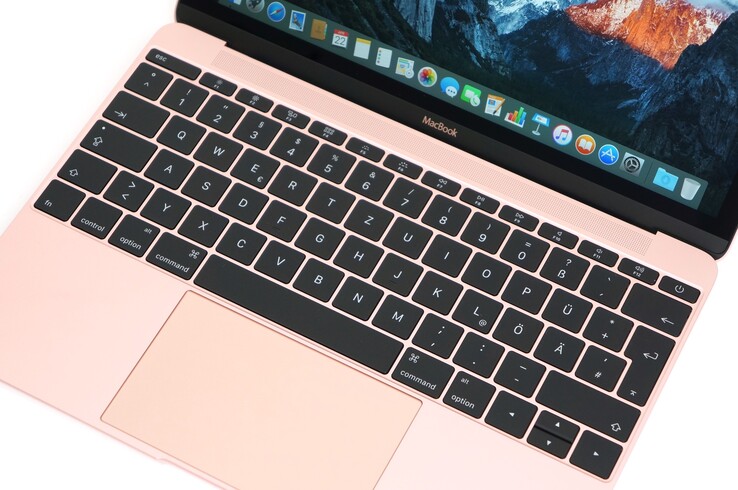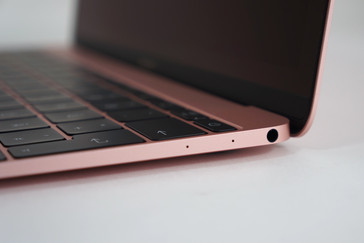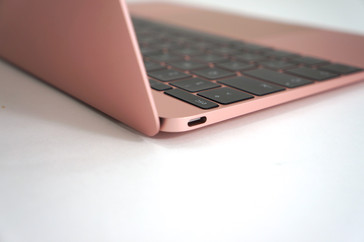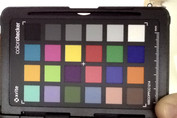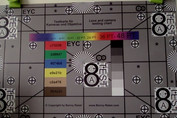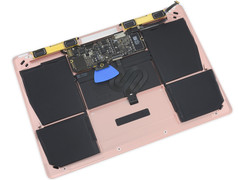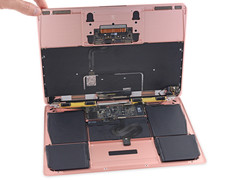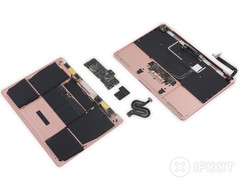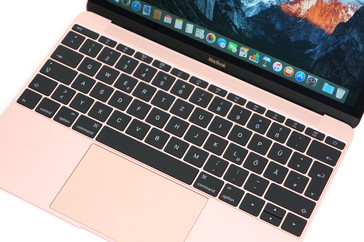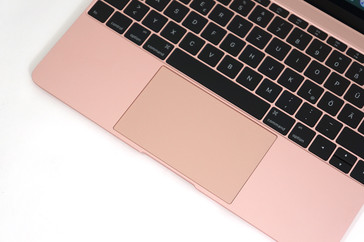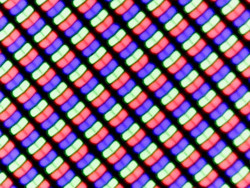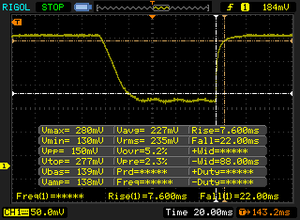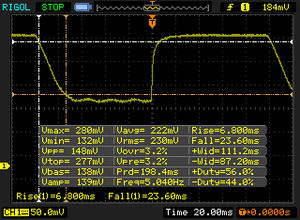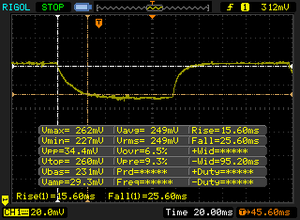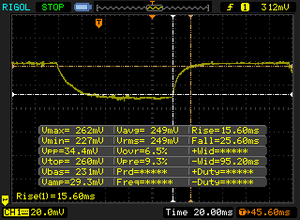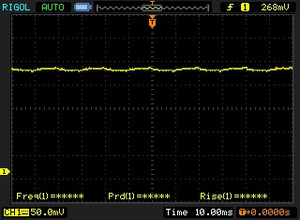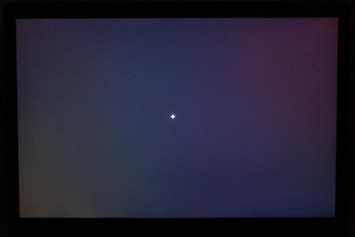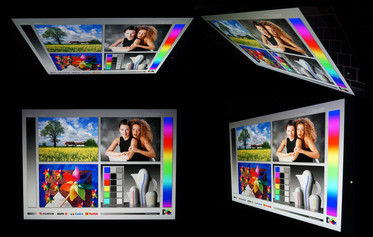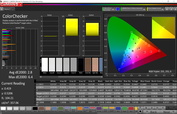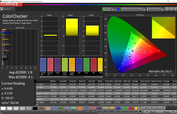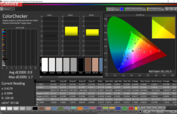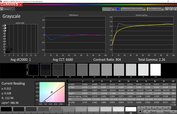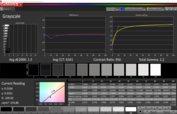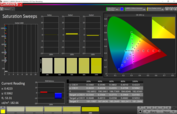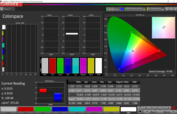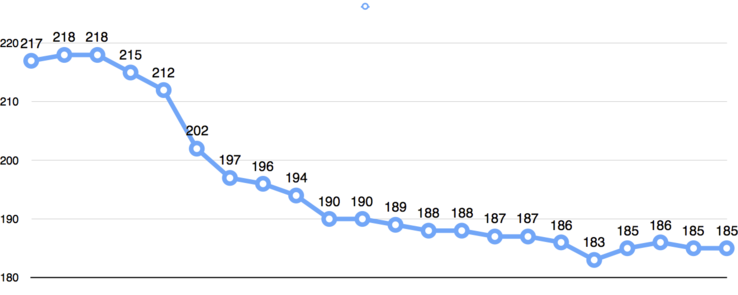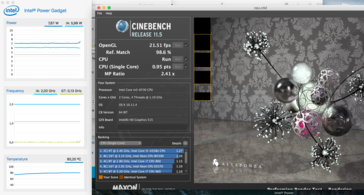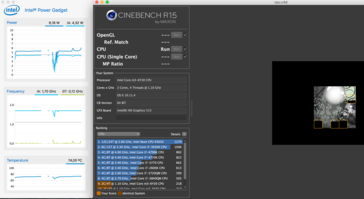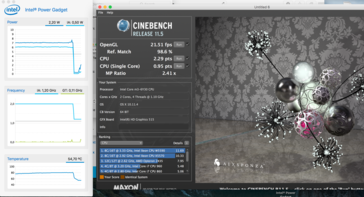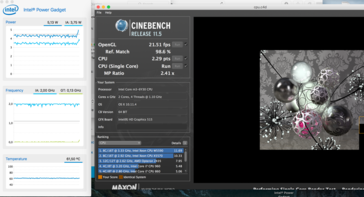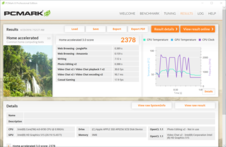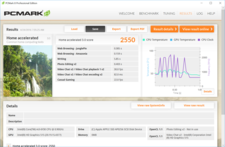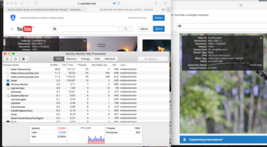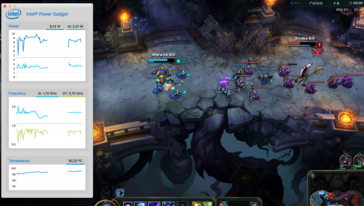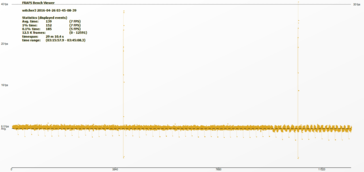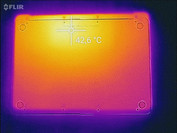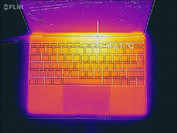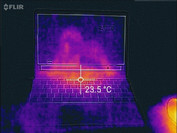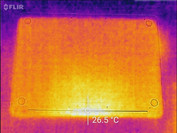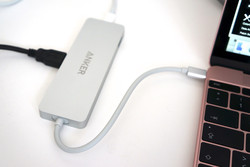Apple MacBook 12 (Early 2016) 1.1 GHz Review

For the original German review, see here.
Apple has relatively quietly refreshed its MacBook 12 series. While the basic principles remained unchanged compared to the predecessor from 2015 (see review), the notebook hardware was brought up-to-date with an Intel Skylake processor and fast NVMe SSD. A slightly bigger battery (41.1 vs. 40 Wh) and a new color called "rose gold" make the refresh complete.
The price of the MacBook 12 remains on the level of the predecessor. A configuration with Intel m3 CPU and 256 GB SSD for 1449 Euros (~$1659) makes the start. The variant with Core m5 and 512 GB SSD costs 1799 Euros (~$2060), while the high-end model with Intel Core m7 processor is priced at about 1949 Euros (~$2231).
Direct comparable competitors are not available in the Windows world. With the ZenBook UX305CA (see review), Asus offers a 13-inch subnotebook, which is also especially slim and passively cooled. In addition, its display resolution of 3200x1800 pixels is even finer. Its street price of about 1200 Euros (~$1374, m7-6Y75 and 512 GB SSD) lets the comparable high-end model of the MacBook 12 appear hopelessly overpriced. However, the UX305CA is also heavier than the MacBook 12 by as much as 300 grams.
If you want to save money but still not do without the elegance from Apple, Tim Cook recommends the MacBook Air 13 (see review), which is available from 1099 Euros (~$1258). However, it is not that up-to-date in terms of display and hardware and uses an active fan.
The Spectre 13 (we reported) recently introduced by HP might also be interesting as it competes as the "thinnest laptop in the world" (10.4 mm). However, it uses Intel Core i processors and is far better than the MacBook in connectivity with three USB Type C ports. The Spectre is supposed to be available from June for an entry level price of about 1499 Euros (~$1716).
Case
As already mentioned in the introduction, the chassis of the MacBook 12 remains unchanged. In terms of stability, haptics and build quality, the laptop is almost perfect. If you can find a weakness in the chassis at all, it might be at the hinges, which move a bit too easily when the display is wide open. The opening angle might change unintentionally when the laptop is subjected to stronger vibrations. But, this is complaining on a high level, since it does not really cause restrictions.
Certainly, not everybody will like the new color "rose gold", which is for example known from current iPhones. However, it might find its fans. During our test we particularly liked how the look of the surfaces changes depending on the light incidence. It goes without saying that the visible pentalobe screws on the underside have the same color as the chassis.
Further information about the MacBook 12's chassis is available in the existing review of the Intel Core m5 variant from 2015 (space gray).
Connectivity
Apple is one of the first manufacturers who use the new USB Type C port. If a compatible adapter is available, the Gen. 1 combo port allows image output via display port, however, only at 30 Hz when connected to an external 4K display, and it provides the notebook with energy at the same time. Apple uses the interface for charging with the included power adapter, which occupies the port, so that it cannot be used for connecting peripherals at the same time. For the latter you'll need an optional adapter from Apple (Type C to USB Type A for 25 Euros (~$28), Type C to HDMI/Type A/Type C for 89 Euros, ~$101) or third-party solutions. For example the Anker Premium USB-C Hub with HDMI, two USB Type-A and USB Type-C for about 50 Euros (~$57) also worked flawlessly in our test.
USB 3.1 Type C Gen.1 supports the same bandwidth as USB 3.0. With an external Adata SE720 SSD, we achieved a transfer rate of 348 MB/s (USB 3.0: theoretically up to 5 Gbit/s, ~640 MB/s).
WLAN Performance
As in the predecessor, an 802.11 ac chip (a/b/g/n compatible) from Broadcom provides Wi-Fi connectivity. In our brand-new test setup with a Linksys EA8500 AC router (at 1 m distance, maximum performance, MSI GE72 with Killer Gigabit-LAN E2400), the MacBook achieved 397 MBit/s in the iperf Client test (sending) and 570 MBit/s in the iperf Server test (receiving). The results are just about the same as the MacBook Pro 13's from 2013 and rank in the mid-field compared to other reviewed devices.
| Networking | |
| iperf Server (receive) TCP 1 m | |
| Apple MacBook Pro Retina 13 inch 2013-10 | |
| Apple MacBook 12 (Early 2016) 1.1 GHz | |
| MSI GE72 965M Ti | |
| MSI CX61 2QC 2970M MS-16GD | |
| iperf Client (transmit) TCP 1 m | |
| Apple MacBook Pro Retina 13 inch 2013-10 (Hinum) | |
| Apple MacBook 12 (Early 2016) 1.1 GHz | |
| MSI GE72 965M Ti | |
| MSI CX61 2QC 2970M MS-16GD | |
Webcam
So far, our impression of the notebook was very good. However, this abruptly ended when we had a closer look at the webcam. The 480p FaceTime camera only features a resolution of 0.3 MP and delivers low-resolution, grainy images. In return, recording and transferring voice works very well. The integrated array microphones can definitely replace a headset.
Maintenance
Although the screws can be easily detected on the underside, it is not really simple to open the chassis. As our colleagues from iFixit found out, Apple created a device which is especially difficult to repair by using, among others, a lot of glue. The system cannot be upgraded at all since all the components are soldered to the small Logicboard.
Input Devices
Keyboard & Trackpad
The input devices of the Apple MacBook 12 remained unchanged. As in the previous year's model, the keys feature a very short travel and the fixed touchpad without mechanical parts only reports clicks to the user by vibrating. However, this works so well that you'll first notice the lack of a mechanical travel after disabling the Force Touch functionality.
Further details about keyboard and Force Touch Trackpad are available in our MacBook 12 from 2015 review.
Display
The display still features a relatively unusual resolution of 2304x1440 pixels (16:10). According to the panel name, it might be identical to the predecessor, although the measurements are slightly different. The brightness of just under 390 cd/m2 in the center segment is very high. The contrast of 823:1 is also good. The color precision is excellent with a DeltaE of only 1.6 (ColorChecker) and 1 (grayscales). The color coverage in the test with Argyll results in a very good 82.2% of sRGB and 61.6% of AdobeRGB. Thus, photographers and designers using the sRGB color space might be very happy.
Exemplary: The Apple does not use PWM for brightness control.
| |||||||||||||||||||||||||
Brightness Distribution: 88 %
Center on Battery: 387 cd/m²
Contrast: 823:1 (Black: 0.47 cd/m²)
ΔE ColorChecker Calman: 1.6 | ∀{0.5-29.43 Ø4.79}
ΔE Greyscale Calman: 1 | ∀{0.09-98 Ø5}
97.8% sRGB (Calman 2D)
82.2% sRGB (Argyll 1.6.3 3D)
61.6% AdobeRGB 1998 (Argyll 1.6.3 3D)
68% AdobeRGB 1998 (Argyll 3D)
95.4% sRGB (Argyll 3D)
66.8% Display P3 (Argyll 3D)
Gamma: 2.26
CCT: 6680 K
| Apple MacBook 12 (Early 2016) 1.1 GHz HD Graphics 515, 6Y30, Apple SSD AP0256 | Apple iPad Pro 12.9 A9X / PowerVR GT7xxx, A9X, Apple 128 GB (iPad Pro 12.9 NVMe) | Apple MacBook Air 13 inch 2015-03 HD Graphics 6000, 5650U, Apple SSD SD0256F | Apple MacBook Air 11 inch 2015-03 HD Graphics 6000, 5250U, Apple SSD SM0128F | Apple MacBook 12 (Early 2015) 1.1 GHz HD Graphics 5300, 5Y31, Apple SSD AP0256 | |
|---|---|---|---|---|---|
| Display | 19% | -39% | -38% | 1% | |
| Display P3 Coverage (%) | 66.8 | 91.2 37% | 40.1 -40% | 40.56 -39% | 67.6 1% |
| sRGB Coverage (%) | 95.4 | 98.1 3% | 59.8 -37% | 60.6 -36% | 95.6 0% |
| AdobeRGB 1998 Coverage (%) | 68 | 79.3 17% | 41.51 -39% | 41.95 -38% | 68.7 1% |
| Response Times | |||||
| Response Time Grey 50% / Grey 80% * (ms) | 41.2 ? | ||||
| Response Time Black / White * (ms) | 30.4 ? | ||||
| PWM Frequency (Hz) | |||||
| Screen | -7% | -57% | -44% | 1% | |
| Brightness middle (cd/m²) | 387 | 399 3% | 329 -15% | 368 -5% | 345 -11% |
| Brightness (cd/m²) | 358 | 393 10% | 310 -13% | 349 -3% | 325 -9% |
| Brightness Distribution (%) | 88 | 92 5% | 82 -7% | 90 2% | 90 2% |
| Black Level * (cd/m²) | 0.47 | 0.22 53% | 0.405 14% | 0.493 -5% | 0.324 31% |
| Contrast (:1) | 823 | 1814 120% | 812 -1% | 746 -9% | 1065 29% |
| Colorchecker dE 2000 * | 1.6 | 2.96 -85% | 3.96 -148% | 3.29 -106% | 1.62 -1% |
| Colorchecker dE 2000 max. * | 4 | 7.51 -88% | 5.22 -31% | 2.51 37% | |
| Greyscale dE 2000 * | 1 | 3 -200% | 3.51 -251% | 3.06 -206% | 1.88 -88% |
| Gamma | 2.26 97% | 2.21 100% | 3.83 57% | 2.68 82% | 2.55 86% |
| CCT | 6680 97% | 7049 92% | 6711 97% | 6397 102% | 6411 101% |
| Color Space (Percent of AdobeRGB 1998) (%) | 61.6 | 71.15 16% | 38.4 -38% | 38.8 -37% | 61.8 0% |
| Color Space (Percent of sRGB) (%) | 82.2 | 97.87 19% | 59.8 -27% | 95.5 16% | |
| Total Average (Program / Settings) | 6% /
-0% | -48% /
-53% | -41% /
-43% | 1% /
1% |
* ... smaller is better
Display Response Times
| ↔ Response Time Black to White | ||
|---|---|---|
| 30.4 ms ... rise ↗ and fall ↘ combined | ↗ 6.8 ms rise | |
| ↘ 23.6 ms fall | ||
| The screen shows slow response rates in our tests and will be unsatisfactory for gamers. In comparison, all tested devices range from 0.1 (minimum) to 240 (maximum) ms. » 82 % of all devices are better. This means that the measured response time is worse than the average of all tested devices (20.3 ms). | ||
| ↔ Response Time 50% Grey to 80% Grey | ||
| 41.2 ms ... rise ↗ and fall ↘ combined | ↗ 15.6 ms rise | |
| ↘ 25.6 ms fall | ||
| The screen shows slow response rates in our tests and will be unsatisfactory for gamers. In comparison, all tested devices range from 0.165 (minimum) to 636 (maximum) ms. » 65 % of all devices are better. This means that the measured response time is worse than the average of all tested devices (31.7 ms). | ||
Screen Flickering / PWM (Pulse-Width Modulation)
| Screen flickering / PWM not detected | |||
In comparison: 53 % of all tested devices do not use PWM to dim the display. If PWM was detected, an average of 8167 (minimum: 5 - maximum: 343500) Hz was measured. | |||
Backlight bleeding is only minimal. However, slight color shifts are noticeable in completely black backgrounds. However, this effect appears stronger on the image than to the naked eye.
The viewing angles are very good; there is hardly any color shift. Subjectively, the brightness also remains very stable.
After calibration with our i1Pro 2 Basic under OS X, the DeltaE value decreased to an excellent 0.9 (average) and 1.7 (maximum). However, the DeltaE value of the grayscales slightly increases after a single calibration run. In return, the gamma value reaches an ideal 2.2. A comprehensive calibration, e.g. with CalMAN, might further improve the result.
Performance
A slim case and a passively cooled SoC do not promise high performance. In addition, our test model is the entry level configuration with Intel Core m3 CPU (1.1 GHz dual-core). Nevertheless, we expect that office applications run smoothly and our MacBook 12 was able to prove that they do so. The passively cooled solution first reaches its limits when load persists.
Processor
As usual for Core M processors, the CPU performance depends on the cooling and the configured TDP of the system. Thanks to a high Turbo clock, the CPU can achieve a very good result in the first run of Cinebench R15. In the multi-core test, the small m3-6Y30 even beats the m7 in the UX305CA (OS X vs. Windows). In the single-thread test, the ranking is no longer that surprising. The m3 MacBook remains behind the Core m5 devices but outperforms the Surface Pro 4 and Galaxy Tab Pro S with m3. The Cinebench results (single and multi) are virtually the same under Windows 10 via Bootcamp. Only the OpenGL test is significantly faster.
You can see when the TDP and cooling start to limit the CPU performance, when running Cinebench R15 Multi in a loop. After four runs, the result falls rapidly and levels off at about 85% of the maximum. Thus, a significantly lower performance has to be expected when the CPU load stays high for a longer time, for example during rendering of videos.
System Performance
Despite a fast SSD, the small MacBook 12 cannot score particularly high in PCMark 8 under Windows 10. The average of all subnotebooks is about 6% faster. Even the model from 2015 achieved a 5% higher score. The fastest notebook with Core m3-6Y30 is the Asus Zenbook UX305CA, which is 11% better. However, Apple is not really known for very good hardware optimization under Windows 10. Thus, the PCMark 8 results do not unconditionally apply to OS X, which unfortunately lacks a comparable system benchmark. The low score compared to the 2015 model can be explained by the lower single-thread performance of the CPU.
| PCMark 8 Home Score Accelerated v2 | 2550 points | |
| PCMark 8 Work Score Accelerated v2 | 3550 points | |
Help | ||
Storage Device
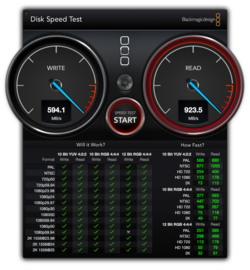
The incorporated Apple SSD AP0256 reports the same name as in the model from 2015. However, it got slightly faster according to the benchmarks and Apple. It belongs to the fastest models in sequential transfer rates but cannot completely keep up in the 4K benchmarks of AS SSD and CrystalDiskMark 3 (both Windows). The SSD in the MacBook 12 2015 was slightly faster in the 4K benchmarks but slower in the sequential tests.
Graphics Card
The integrated Intel HD Graphics 515 GPU certainly is an improvement compared to the predecessor. It can significantly outperform the old HD Graphics 5300 (38% in 3DMark 11, 10% in 2013) and ranks in just behind the HD 515 in the Microsoft Surface Pro 4 (which also comes with a Core m3-6Y30).
| 3DMark 2001SE Standard | 20345 points | |
| 3DMark 03 Standard | 18019 points | |
| 3DMark 05 Standard | 9173 points | |
| 3DMark 06 Standard Score | 6921 points | |
| 3DMark Vantage P Result | 4672 points | |
| 3DMark 11 Performance | 1277 points | |
| 3DMark Cloud Gate Standard Score | 4446 points | |
| 3DMark Fire Strike Score | 682 points | |
Help | ||
Gaming Performance
The small MacBook is hardly suitable for gaming enthusiasts. Only undemanding games like BroForce or League of Legends run smoothly on the Core m. The small cursor keys are not advantageous for gaming, either.
Apart from a short game of BroForce, we have also tested League of Legends under OS X. It ran smoothly in high details and at a resolution of 1440x900 pixels with an average frame rate of 50 fps. The performance first dropped to a still smooth 34 fps in the final fight. Apparently, OS X also delivered full performance on battery, since the frame rate did not fall during the game.
| low | med. | high | ultra | |
|---|---|---|---|---|
| The Witcher 3 (2015) | 7.4 | |||
| World of Warships (2015) | 32.1 | 30.2 | 16.4 | 11.7 |
| FIFA 16 (2015) | 42 severe graphical problems (unplayable slow) | |||
| Fallout 4 (2015) | 0 severe graphical problems (unplayable) | |||
| Need for Speed 2016 (2016) | 6.1 |
Emissions
System Noise
Thanks to fanless cooling and a Solid State Drive, the 12-inch MacBook does not generate a system noise. Moreover, we could not hear transistor whining so far.
Temperature
Our measurements did not show alarming surface temperatures after the WLAN test ran for 8 hours. With a maximum of 26 °C on the top side and 27 °C on the underside, the case remains comfortably cool (ambient temperature: 21.4 °C). While the case reached significantly higher temperatures at the end of 22 runs of Cinebench R15 (multi-thread), these are still not critical. We measured a maximum of 36 °C on the top side and 40 °C on the underside. The palm rests remained relatively cool at 30 °C. During our gaming test, the MacBook gets even a bit warmer with a maximum of 44 °C on the underside and 40 °C on the top side (Unigine Valley). Under extreme stress under Windows, we measured the same maximums. The palm rests also remained comfortably cool here.
(+) The maximum temperature on the upper side is 39 °C / 102 F, compared to the average of 35.9 °C / 97 F, ranging from 21.4 to 59 °C for the class Subnotebook.
(±) The bottom heats up to a maximum of 44 °C / 111 F, compared to the average of 39.3 °C / 103 F
(+) In idle usage, the average temperature for the upper side is 28.4 °C / 83 F, compared to the device average of 30.8 °C / 87 F.
(+) The palmrests and touchpad are cooler than skin temperature with a maximum of 30 °C / 86 F and are therefore cool to the touch.
(±) The average temperature of the palmrest area of similar devices was 28.2 °C / 82.8 F (-1.8 °C / -3.2 F).
Speakers
With a maximum of 84 dB during playing pink noise, the MacBook 12 does not belong to the loudest devices, but it is significantly louder than the average of all devices (77 dB) and certainly subnotebooks (72 dB). Even the 27-inch iMac was only 2 dB louder in our test - respect! The frequency characteristics are also very good and relatively linear from 500 Hz upwards. Compared to our 2015 MacBook sample we could not measure a small peak in the (inaudible) high frequency range. However, this might also have been caused by environment noises.
Surprisingly, the MacBook 12 performs significantly better than the MacBook Pro Retina 13 from 2013. The small 12-inch notebook sounds audibly better and even provides more basses - a notable performance in view of the compact case size.
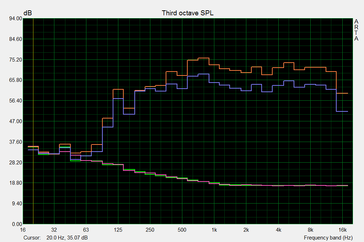
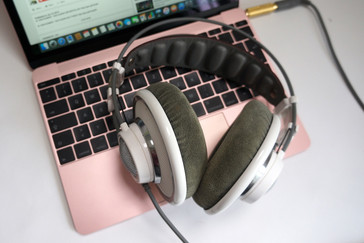
Energy Management
Power Consumption
As usual for Macs, the power consumption is lower under OS X than under Windows via Bootcamp. When the system runs idle, we measure significant differences from 1-3 Watt (for example idle with display off: 2.6 vs. 5.8 Watt). The power saving of OS X works significantly better than under the probably not perfectly tuned Bootcamp. Under maximum load, the limitations of the passively cooled m3 processor become apparent. The device draws 30 Watt for one to two seconds. Afterwards, the power consumption abruptly falls to 22 Watt and to 20.5 Watt another 30 seconds later. As a result, the system requires more energy under extreme load (Furmark and Prime95) than during the old 3DMark06 graphics test (22 Watt).
| Off / Standby | |
| Idle | |
| Load |
|
Key:
min: | |
Battery Life
In a first test, the MacBook 12 proved its good battery life again. With only 115 nit and scaled resolution, it ran for 10 hours and 23 minutes in our Wi-Fi test. With increased brightness (143 nit, level 11 of 16) and normal Retina resolution, the battery life falls to 8 hours and 21 minutes, which is about 9% better than the MacBook variant's from 2015. The effects of the minimally higher battery capacity and the better efficiency of the Skylake processor become apparent here. The slim device performs well when compared to the average of all reviewed subnotebooks (just under 7 hours; 84% of the battery life). By the way, the MacBook Air 13 from 2015 (10 hours) follows the leading Satellite Z30 with 12 hours, while the minimally heavier MacBook Air 11 only lasted 10 minutes longer in the test.
The small subnotebook lasts significantly shorter under graphics load. It achieved just under three hours (2h 53 min) in the Unigine Valley Benchmark with 100% brightness.
Charging the battery took about 2.5 hours during use of the notebook. According to OS X, it achieved 50 % after about 1 hour. The power adapter got quite hot during charging with a measured 52 °C.
Pros
Cons
Verdict
The 12-inch MacBook is and remains an impressive device. Low weight, an excellent display, and its build quality are outstanding properties. However, not much has changed compared to the model from 2015. Slightly improved graphics performance and slightly longer battery runtimes are no reason to change. Due to the lower single-core performance, the Skylake m3 is even slower than its predecessor in several benchmarks (and in everyday tasks). Nevertheless, the performance of the fanless subnotebook is sufficient for most applications. The Turbo can mostly keep the clock rate at 2 GHz if load does not persist for more than several minutes.
Small, light, limited. With the MacBook 12, you need to be willing to accept omissions in the connectivity, but you'll get excellent solutions otherwise.
The MacBook's single USB Type C port is used for charging the device as well. Thus, you'll require an expensive and complex adapter. Moreover, the entry level configuration is not particularly affordable at 1449 Euros (~$1659). In our opinion, it is worth spending 100 Euros (~$114) more on a 13-inch Air because of its significantly better display.
Apple MacBook 12 (Early 2016) 1.1 GHz
- 04/27/2016 v5.1 (old)
Klaus Hinum, J. Simon Leitner




